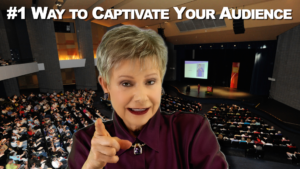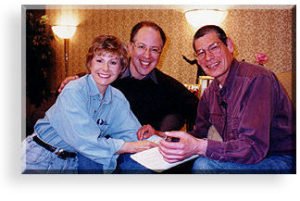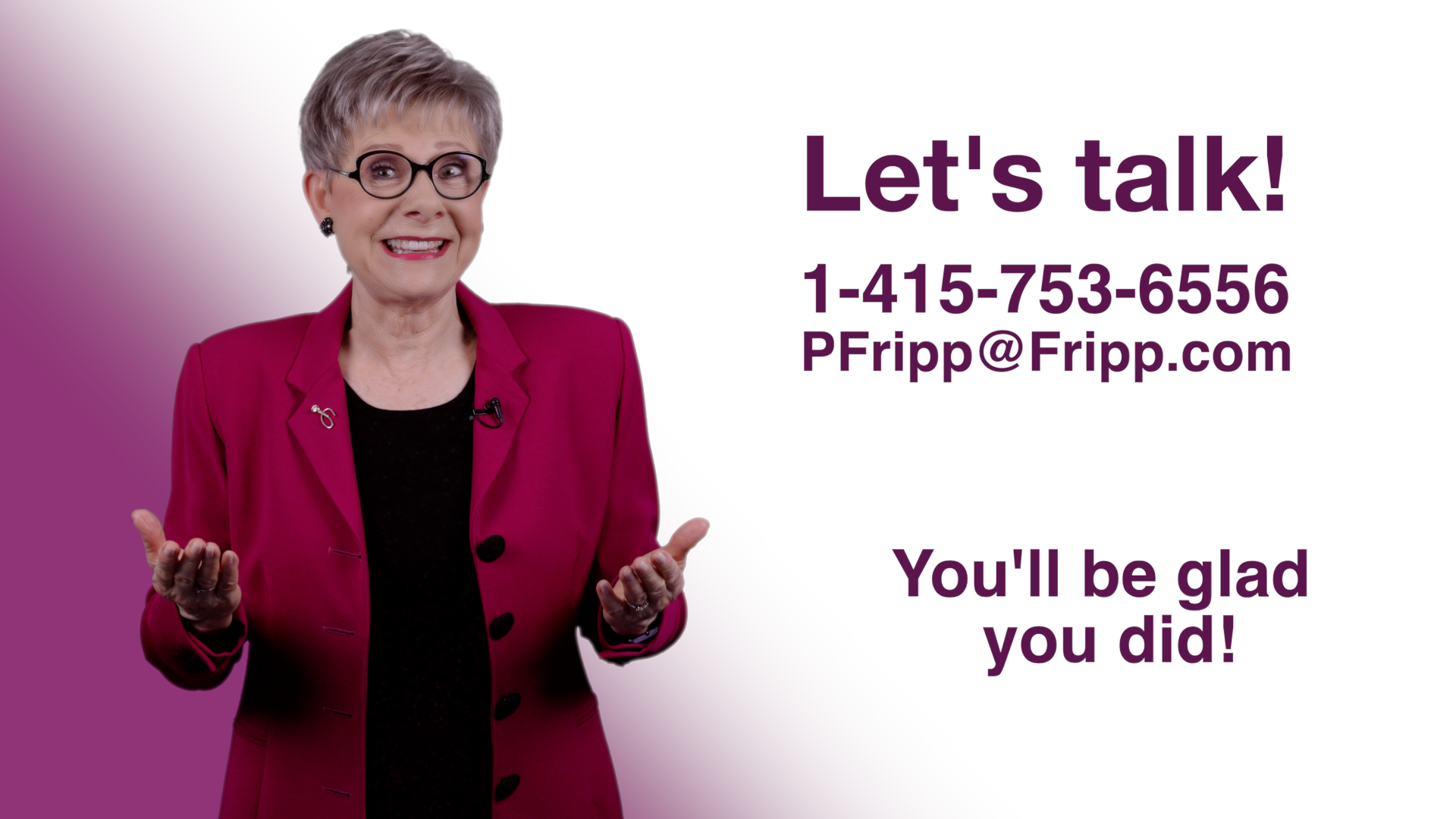
What makes a Hollywood movie great?
Exactly the same principles that will make a good keynote speech great. A great story with a message.
Screenwriter Robert McKee says, “Stories are the creative conversion of life itself into a more powerful, clearer, more meaningful experience.” We all love stories because when told well, have larger-than-life characters, sparkling dialogue, and an emotional reaction from the audience.
Imagine that you have unlimited resources to design a keynote that will make you the hottest commodity on the market.
Where would you go to get the best, highest-priced writers and directors in the world? Hollywood. In Hollywood, you’ll find hundreds of talented people, both in front of and behind the camera, all working together to create one money-making movie. The bad news is that you probably don’t have unlimited resources to hire all those people. The good news is you can still use seven basic Hollywood techniques to increase the impact of your presentation.
1. Start with the Flavor Scene
In David Freeman’s Screenwriting Seminar, he specifies sixteen ways to make the first three pages of a script “kick ass.” If they don’t, producers don’t read the rest of the script. If they don’t read it, they don’t buy it and they don’t make your movie. Good movies often open with a “flavor scene,” grabbing attention and positioning the audience for what is to come. Relate the first three pages of a movie script to the first thirty seconds to three minutes of your speech. Your flavor scene doesn’t necessarily have to lead where the audience expects it to. The opening invites us into the story and foreshadows what is to follow.
2. Use Scene Changes
Early in each movie, the hero commits to some course of action. If we look at a couple of classics that were memorable to me, Rocky Balboa agrees to fight Apollo Creed in Rocky IV. Elle Woods of Legally Blonde resolves to go to Harvard. The sooner this happens, the sooner the audience gets emotionally involved. Next, the lead character licks one challenge and runs smack into another. This involves scene changes. The movie moves from point to point, maintaining interest by changing settings, focal points, emotions, and energy levels. The biggest enemy of a speaker, no matter how good, is “sameness” or lack of variety. Each time you move from story to story or example to example, this is a scene change. Use variety to keep your audience interested. Sadly, I’ve watched intelligent, dynamic, articulate speakers go down in flames because the same energy level was used throughout. Their “scenes” never changed.
3. How to Tell Hollywood Stories

Start by identifying your main theme or purpose–your plot–and any subplots. For example, a retail executive Ed had just an hour and 20 minutes to work with me on an important speech. He was recently promoted and now was speaking for eight minutes to 500 young store managers at an important, high-visibility, company meeting. His topic was a program to get employees to contribute money-saving ideas. His subtext was, “I deserved to get this promotion.” In 8 minutes, he had to excite support for the money-saving program. If he did it well and inspired every store manager to go back to inspire all their employees, the impact could be incredible. (Seventy-five minutes left of our coaching session.) My words to him were,“We don’t have very much time, so you are going to have to trust me, and do exactly what I suggest,” I said. “First, never say ‘good morning.’ It’s boring, it’s obvious, and the previous speakers have already said it. Walk on stage; look at the audience, and say, ‘We are here to talk about heroes.’ In seven words, you’ve just proved that this is not another dull, corporate speech. “‘We are here to talk about heroes,’ you say, ‘They may be sitting behind you. They may be sitting in front of you. They may be you. In the trenches… (names of the company) heroes.’”
Looking for a Great Story with a Message
I asked Ed to tell me a story about someone who had saved the company money. Do you know what he showed me? Statistics! “Statistics aren’t sexy,” I told him. “Numbers are numbing. Where’s the made-for-television movie?” He had no idea. We phoned the Accounting Department and got the stories behind the statistics. (Sixty minutes to go.) One young man in the shipping department had noticed that seven company newsletters had been sent to the same location, on the same day, and were going out in separate packets. This mailroom hero thought, “Why don’t I pack them together with a note asking that they be distributed on the other end?” This worked well, so he urged his colleagues to question similar duplications. “Look, guys,” he told them, “we own stock in our company, not Fed-Ex!” His idea saved them $200,000 that year. Whenever you tell a story, be ready to answer the audience’s unasked question. In Ed’s case, his audience would be wondering, “What did they do with that $200,000?” We researched some answers and added interesting factoids: “$200,000 is 18 miles of shelving. It’s designing an additional garment size. It’s a month of local commercials.” (Forty minutes to go in our session.)
Every Speech Needs a Challenge
To close, Ed would challenge his audience: “As our store managers, you and your teams have good ideas. Do you write them up and get them in the process to be evaluated? You may be thinking, ‘What’s in it for me?’” This is where Ed would talk about cash rewards. (Thirty minutes to go.) Ed rehearsed his eight-minute speech, polishing, tightening, and adding more energy with each run-through until he could do it without notes. (Time’s up!) He concluded his speech by playing David Bowie’s Heroes, which tied the opening into the close in a perfect circle. Ed had a great story with a message.
When he delivered the speech we had worked on, I was in the audience. The audience laughed, applauded, and were engrossed.
4. Create Captivating Characters
The late comedy impresario John Cantu knew that speakers mustn’t be the heroes of all their stories. Together, we analyzed one of his speeches and found he mentioned sixty-two different characters! Learn from Hollywood. Fill your stage with other exciting performers, real and imaginary.
What does Hollywood do to make characters even more alive? In another of my favorite classics Analyze This, Robert De Niro is a Mob boss who ordered people killed. Yet, in the end, he gets only eighteen months in prison. Why? Because he is likable. How can you like a killer? Because Hollywood builds in the “likeability factor.” The audience ends up pulling for him, despite his flaws. If Hollywood techniques can make audiences like a Mob boss, surely the same techniques can get them on your side too. Build this likeability into your characters in their back story description. With movies, we do have “suspension of disbelief.” (See note later)
Start by identifying the values, needs, and wants of your audience. Then tell them about characters that also share them. My audience at the Governor’s Conference for the State of Maryland was made up of government employees. Like their counterparts in corporate America, many felt under-appreciated, and not respected by others for their dedication to their jobs and the communities they served. Their theme was Performance Excellence.
In my presentation, I made the comment that “The best aspect about performance excellence on the job, is that you take it home, and it has a positive effect on your family life. One of my friends is an everyday hero like you.” Next, I told them about Bobby Lewis, a proud father who took his two boys to play miniature golf. “How much to get in?” he asked the ticket taker. “$3 for you and for any kid who is older than six. Free for kids younger than six.” “Well, Mikey is three and Jimmy is seven, so I guess I owe you $6.” “Hey, mister,” the ticket taker replied. “You like throwing your money away? You could have told me the big one was only six. I wouldn’t have known the difference.” “Yes,” Bobby replied, “but the kids would have known the difference.”
The 2000 people in that audience broke into spontaneous applause. Why? Because that simple story about a father with values that represented theirs was told through dialogue and had a simple message. It’s not what you say you believe that counts. It’s what you model, encourage, reward, and let happen. Did I know they were going to applaud? No. Did I wait and let them enjoy it? Yes. Bobby Lewis had given me a great story with a message.
Here’s your Frippercise: Count how many characters appear in your speeches. They are what makes a Hollywood story–flesh and blood characters that the audience can relate to.
5. Construct Vivid Dialogue

Notice the conversation I described above between my friend Bobby Lewis and the ticket seller. Your stories come alive when you can use real dialogue between your characters. Don’t report on the conversations as most speakers seem to do, tell the stories in the character’s dialogue. Naturally, you may have to edit and dramatize it.
6. Provide a Lesson Learned
Legendary Hollywood producer Sam Goldwyn said, “If I want to send a message, I’ll use a telegram.” Yet, all great films–and speeches–have a message. In many of the movies, I love there are explosions and car chases. However, when action and thrills serve a compelling story and finish up with heroic characters, and a heart-tugging or eye-opening conclusion, we’re talking about unforgettable Oscar winners.
Hollywood classics model these ideals. Ingrid Bergman leaves Bogart and gets on the plane with Paul Henreid in Casablanca because honor comes before love in wartime. Dietrich abandons her rich lover Adolphe Menjou in Morocco and follows Gary Cooper barefoot into the desert because love comes before money. Harrison Ford, Jimmy Stewart, Jim Carey, Julia Roberts, and Tom Hanks struggle against huge odds because it’s better to lose than never to try. The funniest or most exhilarating story will leave the audience a little empty if you don’t tie it into your theme and provide a lesson learned. A great story with a message.
7. Explore Collaborating

Collaboration is mandatory in Hollywood, and it can work for speakers too. At a magical time in my life, I used to brainstorm with copywriting expert David Garfinkel and the late, great John Cantu, the San Francisco comedy legend. At one session, John was just out of the hospital after serious cancer surgery. We asked him to describe his experiences. In a few minutes, we were laughing so hard I said, “Start over we need to record this.” As he talked, David Garfinkel kept adding dramatic effects, and I pointed out key lines of dialogue. When John finished, we had the foundation for a speech called, “Laughing All the Way to the Hospital.”
It was full of drama and human interest, both funny and poignant. Our collaboration was so exciting that we transcribed the recording and turned the experience into a National Speakers Association seminar. We built a set on stage, replicating my living room with hotel furniture. Then we re-enacted the whole experience, freezing the action every now and then so moderator Janelle Barlow could point out to the audience the key learning points in what we were doing. It was an incredible, fun, exhilarating learning experience.
John had a great story with a message.
Note: Suspension of disbelief is the intentional avoidance of critical thinking or logic in examining something unreal or impossible in reality,
such as a work of speculative fiction, in order to believe it for the sake of enjoyment. Aristotle first explored the idea of the concept in its relation to the principles of theater; the audience ignores the unreality of fiction in order to experience emotions.
In Memory of John Cantu

By the way, John Cantu lived five more exciting, vibrant years after this incident. His cancer did return and in May of 2003, we said “Goodbye” to John with a packed house. As was his request, David Garfinkel was the emcee and I had the honor of being the “Headliner.” John and his magnificent contribution to thousands will always be with us. In true Hollywood style, John was like the character in many movies. He was an “everyday man who took what life dealt him and handled it with humor.”
John Cantu ran the Holly City Zoom comedy club. This is where Robin Williams, Dan Carvey, Paula Poundstone, and many other famous comedians began their careers. John Cantu will never be forgotten by those who met and knew him.
David Garfinkel is known as “The World’s Greatest Copywriting Coach.” Why not subscribe to David Garfinkel’s Copywriter podcast?
Want help to find your great story with a message? If you need help and 24/7 access to my advice take a trial of FrippVT.
“The information in FrippVT is as valuable as any college course I’ve taken. This is a resource that everyone should know about. The investment is worth ten times more than I paid and has been life-changing. My fees, recommendations, and referrals have increased dramatically. I am delighted.” Mitzi Perdue, author of How to Make Your Family Business Last
“Patricia Fripp’s super-power is she can listen to a superb presentation and find ways to make it even better.” Krister Ungerböck, Author of Talk Shifts
“Patricia Fripp is amazing. As a speech coach, you’ll never find anyone with her wisdom, experience, and ability. Once I began to work with her, she improved my speaking style immediately. Her ability to listen to what her clients want to say and instantly give them the right words to use is incredible. Patricia can take an average presentation and quickly transform it to become great.
She takes time to explain and teach her clients how to think about their speech structure and language so that they are equipped to apply the same strategy moving forward. Patricia truly cares a lot about her clients’ success. You get both a coach and a fan when you partner with Patricia.” – Bhavin Shah, CEO & Founder, Moveworks


I led a funeral service once with these ideas in mind and the people thoroughly enjoyed hearing about their loved one! Hollywood has a lot to teach us about telling compelling stories!
“$3 for you and for any kid who is older than six. Free for kids younger than six.”
But then, we still don’t know how much fee is for a child that is exactly six, do we?….
Well, I actually say six or younger when I
tell the story!